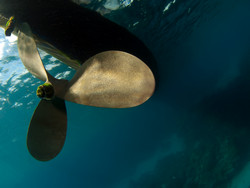Silent running – restoring quiet to the oceans
Cavitation is a noisy, vibration-inducing phenomenon where water ‘cold-boils' at low pressure, causing shock waves when the cavitation bubbles collapse upon entering areas of higher pressure resulting in noise bursts. This underwater noise, created by ever-increasing maritime traffic, may negatively affect large sea mammals and fish. The EU-funded SONIC (Suppression of underwater noise induced by cavitation) project was set up to understand, map and minimise background noise caused by shipping. The initiative brought together world-leading hydrodynamic institutes, noise experts, propeller designers, universities, European shipyards and marine biologists. Their objective was to develop guidelines for determining and mitigating the underwater noise emitted by shipping in the European seas. Project partners developed techniques to model cavitation noise through the use of experiments at the model scale and through computer simulations. Full scale measurements on a dedicated test vessel as well as close to a busy shipping lane were also performed to validate the numerical and experimental techniques. Researchers also mapped the spatial distribution of sound caused by a single ship (a noise footprint) and sets of ships in an area (a noise map). The Automatic Identification System (AIR) data transmitted by vessels was used with radiated noise models to generate these noise maps. An underwater noise footprint and mapping tool (NFMT) was developed and tested. The NFMT can be used in the implementation of the monitoring for descriptor 11 of the European Marine Strategy Framework Directive, which refers to the introduction of energy, including noise, into the marine environment. The guidelines drawn by the project partners can serve as reference document. This will be of use to national authorities, classification societies, ship designers, builders and operators, and policymakers from the EU and International Maritime Organisation. By helping to quiet the oceans in this way SONIC will improve the environmental status of European waters and the welfare of marine life.
Keywords
Ship noise, noise mapping, cavitation, machinery, Underwater noise guidelines, testing, validation



